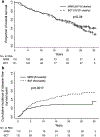Twenty-five year results of the national cancer institute randomized breast conservation trial
- PMID: 22113254
- PMCID: PMC8369835
- DOI: 10.1007/s10549-011-1867-6
Twenty-five year results of the national cancer institute randomized breast conservation trial
Abstract
Breast conservation therapy (BCT) consisting of lumpectomy and postoperative radiation has become an accepted alternative to mastectomy (MRM) for the treatment of early stage breast cancer. We currently report the 25 year outcomes of a single institution, prospective, randomized clinical trial at the National Cancer Institute. 237 women with pathologically confirmed invasive breast tumors 5 cm or less were accrued between 1979 and 1987 and randomized to receive either BCT or MRM. Overall survival was the primary endpoint. Patients with node positive disease were included and treated with doxorubicin and cyclophosphamide. Both arms received axillary dissection. BCT patients had radiation to the whole breast followed by a boost. At a median follow-up of 25.7 years, overall survival was 43.8% for the MRM group and 37.9% for BCT (P = 0.38). Although the cumulative incidence of a disease-free survival event was higher in BCT patients (29.0% MRM vs. 56.4% BCT, P = 0.0017), the additional treatment failures were primarily isolated ipsilateral breast tumor recurrences (IBTR's) requiring salvage mastectomy. 22.3% of BCT patients experienced an IBTR. Distant disease and second cancers were similar in both arms. After 25 years, long term survival between BCT and MRM continues to be similar in patients treated for early stage breast cancer. Patients receiving BCT may be at risk for additional treatment-related morbidity, which may occur as a late event. Further studies are required to delineate patients at higher risk for these events, and prolonged follow up should be encouraged after treatment for all women.
Figures



References
-
- Anderson SJ, Wapnir I, Dignam JJ, Fisher B, Mamounas EP, Jeong JH, Geyer CE Jr, Wickerham DL, Costantino JP, Wolmark N (2009) Prognosis after ipsilateral breast tumor recurrence and locoregional recurrences in patients treated by breast-conserving therapy in five National Surgical Adjuvant Breast and Bowel Project protocols of node-negative breast cancer. J Clin Oncol 27:2466–2473. doi:10.1200/JCO.2008.19.8424 - DOI - PMC - PubMed
-
- Arriagada R, Le MG, Rochard F, Contesso G (1996) Conservative treatment versus mastectomy in early breast cancer: patterns of failure with 15 years of follow-up data. Institut Gustave-Roussy Breast Cancer Group. J Clin Oncol 14:1558–1564 - PubMed
-
- Blichert-Toft M, Nielsen M, During M, Moller S, Rank F, Overgaard M, Mouridsen HT (2008) Long-term results of breast conserving surgery vs. mastectomy for early stage invasive breast cancer: 20-year follow-up of the Danish randomized DBCG-82TM protocol. Acta Oncol 47:672–681. doi:10.1080/02841860801971439 - DOI - PubMed
-
- Clarke M, Collins R, Darby S, Davies C, Elphinstone P, Evans E, Godwin J, Gray R, Hicks C, James S, MacKinnon E, McGale P, McHugh T, Peto R, Taylor C, Wang Y (2005) Effects of radiotherapy and of differences in the extent of surgery for early breast cancer on local recurrence and 15-year survival: an overview of the randomised trials. Lancet 366:2087–2106. doi:10.1016/S0140-6736(05)67887-7 - DOI - PubMed
Publication types
MeSH terms
Grants and funding
LinkOut - more resources
Full Text Sources
Medical

